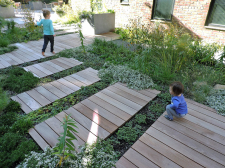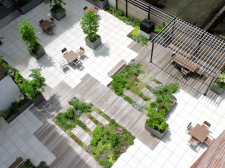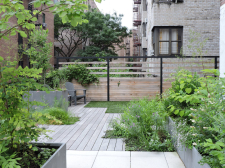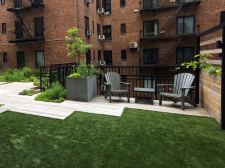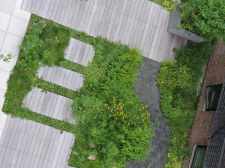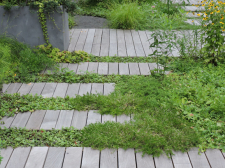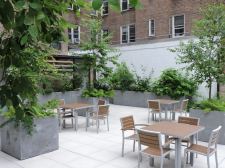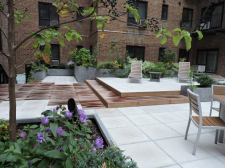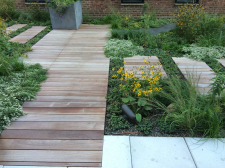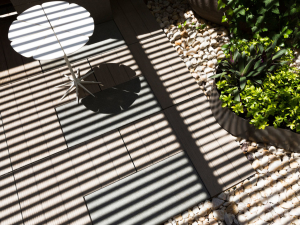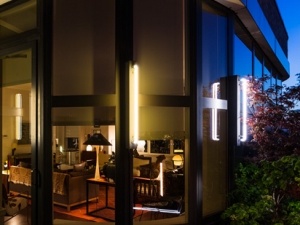 Simbiótica Living Roof, New York, NY
Simbiótica Living Roof, New York, NY
About the Project: Creating a Dual-Use Urban Oasis
In Inwood, Manhattan, CDL/S transformed a vacant 7,000-SF parking garage rooftop shared by three adjoining co-op buildings into a robust, ecologically sound, and modern oasis—providing outdoor recreation opportunities and respite for its co-op residents and habitat services for local wildlife, while integrating low-impact development measures like stormwater management, efficient water usage, and environmentally responsible material sourcing. Through both its form and function, Simbiótica Living Roof embodies a harmonious intersection of urban and wild fabrics, and promotes coexistence between humans and the greater natural world.
To accommodate a broad range of activities and users of all ages, a series of sub-spaces was designed: a tree grove with cafe tables, a sun deck, intimate nooks, an artificial play lawn, and an open flex space. These nodal spaces are sited around a green roof and connected via an armature of truly sustainable Guatemalan manchiche hardwood decking. The centrally located, intensive living roof captures the vast majority of storm water in situ through soil absorption and plant uptake. Additionally, a rain sensor sited within the green roof serves as an irrigation control to save on water resources during precipitation events.
The living roof system supports an exclusively native designed plant community of 27 American perennial plant species and cultivars, many of which are essential to the survival of regional pollinators and migratory birds, and one ground cover listed as “threatened” by the New York State Department of Environmental Conservation. A set of reinforced stone resin planters hosting another 30 indigenous perennial plant species supplements the native green roof and enhances its ecological impact as a source of wildlife food and habitat. The plant palette is aesthetically composed to provide seasonal interest for residents without relying on conventional annuals, and is ecologically compatible within the wider regional mosaic of parks, green spaces, and wilderness areas.
The stone gray planters, handmade by artisans in New York’s Hudson Valley region, are strategically placed to soften the building facades, create shade, and add visual interest. They contrast well against the color of the pavers beneath them—a lighter gray, chosen to reduce heat absorption and mitigate the urban heat island effect by reflecting solar radiation. Fences and a large pergola further delineate space, provide privacy, and screen out off-site views while providing the structural support necessary for vine growth.
These design features synergize with the living roof and planter system to make the landscape truly dual-use, as both a relaxing, reinvigorating urban oasis for co-op residents and a designed patch habitat that supports native flora and fauna and provides a welcoming rest stop for migratory birds.
Helping Pioneer a New Era of Sustainable Rainforest Hardwood
Simbiótica Living Roof breaks new ground with the use of truly sustainable manchiche hardwood from the Uaxactún Community Forest in northern Guatemala. To source this low-impact, FSC-certified lumber as the decking stock for this project, CDL/S turned to an innovative rainforest conservation program spearheaded by the Wildlife Conservation Society and Pilot Projects Design Collective in direct partnership with the inhabitants of Uaxactún Community Forest. Through a novel conservation model, the Uaxactún Community Forest operates by government concession, practicing reduced-impact logging and milling on a 40-year cutting cycle while dedicating two-thirds of its overall concession—hundreds of thousands of acres—to rainforest preservation. The manchiche, also referred to as “Mayan mahogany,” in this way is a renewable, single-origin, and community-managed resource. With high density and attractive natural color, this sustainable hardwood not only performs well as a long-lasting landscape material, but it also helps to foster a mutually beneficial relationship between the human and ecological communities—from northern Guatemala to northern Manhattan.
For more information about this sustainable forestry program, we invite you to watch this short talk by Dr. Jeremy Radachowsky, Director of Mesoamerica and Western Caribbean at the Wildlife Conservation Society, speaking on site at Simbiótica Living Roof.





